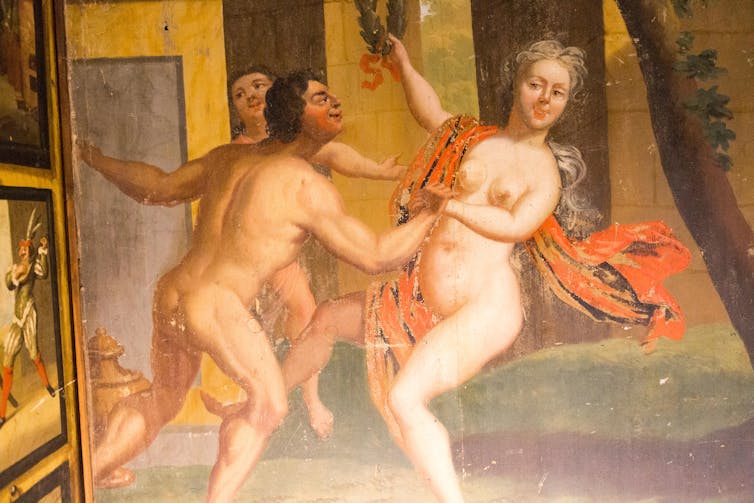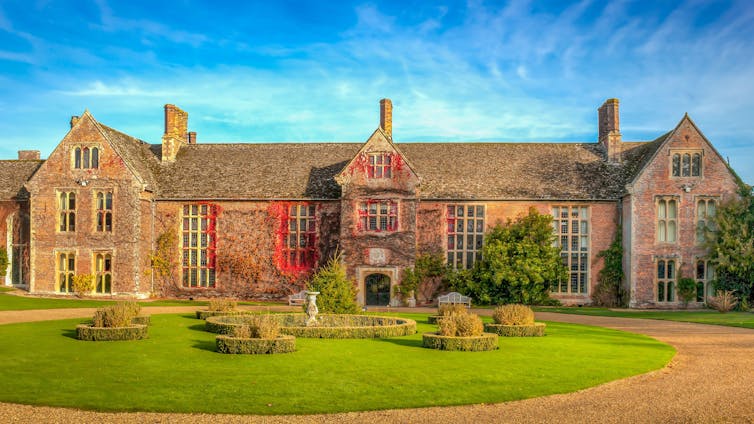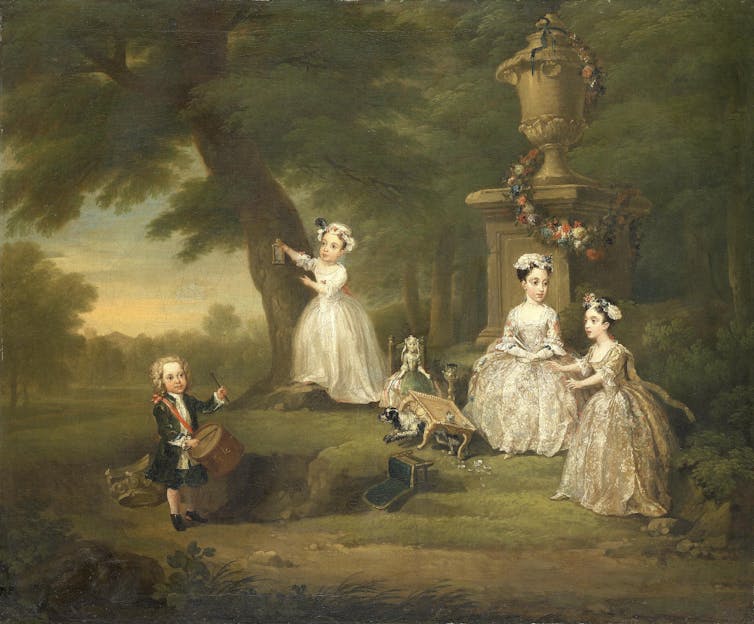On the banks of River Kennett, Wiltshire, sits an Elizabethan country house. You might know Littlecote if you enjoy fly fishing or, if you’re interested in civil war re-enactments – it possesses a unique Cromwellian Chapel and an outstanding Roundhead armoury. Above all, however, Littlecote is known for the many mysteries that shroud it: colourful ghost sightings, a cursed elm tree, tales of tragedies and many puzzling local legends inflect its knotty history.
One such legend, that of Littlecote’s Dutch parlour, is widely considered true. The ceiling and wood-panelled walls of this room are covered in paintings believed to be the work of Dutch sailors, captured and held at Littlecote during the second Anglo-Dutch war (1665-67).
It’s an intriguing story, but one that didn’t sit quite right with me when I first caught a glimpse of the wonderful room in a grainy photograph in the 1990s. I let those thoughts fall to the back of my mind until I visited Littlecote in 2020 and was once again puzzled by the style and date of the paintings. I had a hunch that the true story of the Dutch parlour paintings was far more impressive and important than the accepted origin legend of the sailors.
This set off months of research and my lockdown has been spent challenging this fanciful tale with a completely new question: could Littlecote’s Dutch parlour have been painted by the great William Hogarth?
Saucy scenes kept under wraps
Born in London in 1697, Hogarth initially worked as an engraver, book illustrator and house decorator. None of his wall paintings survive from before 1730, when he finally established his independent career as “one of the finest painters the country ever produced”.
My new research suggests that the Dutch parlour was painted by English artists in the 1720s, not Dutch artists in the 1660s. Possibly, it contains precious surviving examples of Hogarth’s lost early wall paintings. So to me, this finding represents one of the great unasked questions of English art history. It matters for Littlecote, but even more for everyone interested in British heritage and its greatest 18th-century painter.
Strangely, given its memorable paintings, the Dutch parlour doesn’t feature in accounts of the house before the 1890s, when the Pophams, its owners from 1589 to 1929, moved away and brought in tenants.
The Pophams obtained the property in 1589, as a bribe to Queen Elizabeth I’s notorious lord chief justice, Sir John Popham, for letting Littlecote’s previous owner, “Wild” William Darrell, get away with a series of crimes. Darell’s sordid tale of infanticide and incest became famous around the country, inspiring a poem by Sir Walter Scott, Rokeby. Surprisingly, the parlour doesn’t register in the poem either.

Several of the parlour’s large-scale Bacchanalian scenes feature saucily cavorting, podgy male and female nudes. No doubt, these played a part in suppressing public knowledge of the room until the final years of the Victorian period.
Yet when mentions of the Dutch parlour did start registering in accounts of Littlecote, they always included its origin legend.
In an 1895 article on the house, the Reverend Alfred Henry Malan identifies its artist as “a Dutch officer, prisoner here on parole, anxious to return the courteousness of his host by some pleasing memento of his skill”. In 1900, the antiquarian Vernon James Watney claimed that the parlour was painted by Dutch prisoners taken in a naval battle during the time of Charles II and confined at Littlecote during the 1660s.
This origin legend remains almost universally accepted. It is repeated in guide books and even by the surprisingly few art historians who have commented on it.
Back in the 1990s, when I first saw the photo of the room, the 1660s date given for its paintings didn’t feel right. It was much earlier than their style suggests.
Two walls of the Dutch parlour illustrate 17th-century literary bestsellers. Its west wall features scenes from Miguel de Cervantes’ novel Don Quixote. The scenes on its east wall illustrate Don Quixote’s most successful English spin-off, the royalist Samuel Butler’s three volume poem Hudibras.
Ditching the Dutch sailors
Two decades after I saw the photo I worked on an article on Hudibras. My research on the poem confirmed my suspicions that although this bestselling text was indeed first published in the 1660s, Littlecote’s Hudibras images must have been painted after 1710 since they closely follow the book illustrations for the first illustrated edition, published only in 1710.
These same book illustrations inspired the earliest important art of William Hogarth (1697-1764), two print series illustrating Hudibras. Their publication (both in 1726) sealed his artistic reputation.

Buoyed by this, my year of concentrated study in lockdown uncovered new evidence that goes a long way in confirming that Hogarth was involved in painting the parlour. The room’s paintings barely register with art historians and are not even in the two most important publications that helped me understand them.
The first is Elizabeth Einberg’s complete catalogue of Hogarth’s paintings. Einberg confirms that none of his known paintings predate his 30th birthday. Hogarth’s early career produced drawings, prints and book illustrations, but no surviving paintings.
The other is Peter Black’s article on Hogarth and house decoration, which accompanied his temporary exhibition in the University of Glasgow’s Hunterian Art Gallery. I viewed it in June 2016 and noticed that the main exhibit, a newly discovered panel painting of a scene from Hudibras, closely resembles one of the Littlecote Hudibras scenes. It also uses the same technique seen at Littlecote: paint applied directly onto wooden panelling.
Black’s article attributes the Glasgow panel to a lost painted room by Hogarth and dates it to around 1724, shortly before Hogarth’s two celebrated Hudibras print series. So it was clear that the Dutch parlour’s Hudibras images can’t have been painted in the 1660s or by Dutch prisoners of war. They can’t predate the 1710 English book illustrations on which they are based, which also inspired Hogarth’s greatest early works of arts.
All this was well and good, but I had to place Hogarth at Littlecote in the early 1720s.
Undiscovered national treasure?
My investigations into this issue could help solve a puzzle that troubles Hogarth experts. They can’t agree on identifying the five children depicted in a pair of his paintings in the National Gallery of Wales, Cardiff. No portrait sketches survive for Children at Play I and II. Both dated 1730, they are thought to depict children of either Thomas Fermor, 2nd Baron Leominster, or Lieutenant General William Anne Keppel, 2nd Earl of Albemarle.

I, instead, believe that the paintings depict all five children of Edward Richard Montagu, Viscount Hinchingbrooke.
Current identifications for the children in the two Cardiff paintings are not a good fit. Art historians don’t understand why the oldest boy is missing from one painting or why the paintings’ first known owner is a Victorian called William Beaumaurice Rush. They puzzle over why there are too many or too few children and their strangely proportioned bodies.
I believe that Hogarth produced the paintings as a commission in London in the late 1720s. Edward Richard Montagu, Viscount Hinchingbrooke’s wife Elizabeth was born into the Popham family, the longterm owners of Littlecote. When Montagu died in 1722, Elizabeth Popham and their five children are thought to have moved back to her childhood home until her second marriage in 1728. So I suggest that the number of children, their ages and curious proportions fit with Hogarth sketching portrait heads of the five Montagu children in the early 1720s, at Littlecote.
In further strong support of my identification of the children, Rush eventually inherited the paintings via his great-aunt, Laura Rush, wife of Edward and Elizabeth’s grandson Basil Montagu.
So are the Dutch parlour paintings an exceptional unrecognised British art treasure? Was Hogarth involved in their creation? My detailed findings go a long way to proving that the answer to both questions is “yes”.
Littlecote’s relevance to our understanding of William Hogarth isn’t yet totally clear. Post-lockdown, we will gain valuable insights from art-historical, heritage, archive and library investigations. Whatever they uncover, I believe that we must not further delay giving Littlecote’s Dutch parlour its full due as a great British heritage site.

